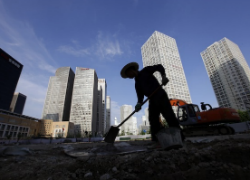Chinese officials recently announced their intention to move 250 million rural residents into cities over the next decade in an effort to reform China’s economy. The goal is to create a new class of urban consumers and increase demand domestically, thereby making economic growth more sustainable. The policy follows in the footsteps of previous actions by the Chinese government to expropriate farmers’ land for development while providing little to no compensation. This mass urbanization could prove to be similarly controversial.

China’s economic success in sustaining economic growth through the last decade has been based primarily on exports. It accomplished this by a combination of low wages, currency controls, and investment in manufacturing, in turn becoming the world’s largest exporter in 2010. Recent forecasts have predicted that China’s growth will slow in the next few years, prompting officials to seek a more sustainable economic strategy, termed ‘rebalancing’. Urbanization, or relocating peasants to urban centers, is a highlight of the new strategy. The idea is that by providing rural farmers with apartments in cities, they will find better paying jobs and become a new consumer class, thereby increasing domestic demand and allowing China to be less dependent on exports. The plan is not without its drawbacks.
Problems have already arisen in this process. Jobs are not readily available for the unskilled peasant class, forcing laborers to take jobs significant distances from their subsidized housing. Urban living also has a higher price tag than a rural lifestyle, requiring a substantial portion of income for utilities and basic necessities like heat and electricity. Of course, farmers have no leverage in this process as urban land is owned by the government and rural by local farmers collectively. Without sufficient property rights, farmers are dependent on the meager subsidies provided by the government once moved into the city, while the market value for land is not truly reflected in the costs for development, leading to inefficiencies in land use and availability.
The last time China attempted economic engineering of this scale was in 1957 with Mao Zedong’s Great Leap Forward. Rural peasants were responsible for providing the food supply for the country’s rapid modernization as well as laboring in heavy industry like iron and steel in backyard furnaces. The result was the largest famine death toll in world history. While technology and improved planning would hopefully prevent a recurrence of famine, there are nonetheless several flaws in China’s urbanization plan. The most glaring is that consumption growth follows an increase in disposable income, which will not occur if wages continue to be suppressed by maintaining a surplus of unskilled labor in the market. Unemployment could lead to discontent and, in turn, a more organized opposition to the Communist parties as farmers are already the most vocal opponents to government actions. Additionally, emphasizing consumption rather than investment in innovation or technology will limit the future growth of the economy.
There is little doubt that China’s economic strategy must adapt to a more sustainable model, although it is yet to be seen whether urbanization will result in continued subsistent existence for peasants or a new era of prosperity. Along with environmental concerns and an aging population, China has its work cut out for it.
Alex Milgroom is a rising 3L at the University of Denver and the Online Editor-in-Chief of the Denver Journal of International Law and Policy.

